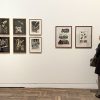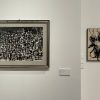Raoul Schultz
Opere 1953-1970
22 March – 8 June 2025
Venice, Ca’ Pesaro – International Gallery of Modern Art
Dom Pérignon Rooms, 2nd floor
Curated by
Stefano Cecchetto
Elisabetta Barisoni
Starting from the works of the Venetian artist Raoul Schultz (Leros, Aegean, 1931 – Venice, 1971) preserved in the civic collections of the Galleria Internazionale d’Arte Moderna, the exhibition presents a corpus of over fifty paintings from important private collectors, including Daniele Tiozzo’s extensive collection. The exhibition seeks to illustrate Schultz’s whole creative career in a chronological sequence, while bringing together his different themes and experiments.
The layout begins with the works present since his first participations in the group exhibitions of the Opera Bevilacqua La Masa in the 1950s, with figurative paintings devoted to representations of Venetian architecture, until the more mature experiences of the Prospettive curve and the Nuove strutture in the early 1960s. The mention of his beginnings in the context of the Opera Bevilacqua La Masa places his production in the cultural context of the post-war period, when Venice and Mestre were at the centre of very lively developments in the figurative arts. This was also the period of the close friendship between Schultz and Tancredi, when they shared a studio in Palazzo Carminati.
Painter, illustrator, graphic designer and set designer, Schultz also produced significant works in the cinema with his friend Tinto Brass, for whom he created the sets for the film Chi lavora è perduto in 1963. In the same years he extended his interest in comics, becoming friends with Hugo Pratt and other artists active around the magazine “L’Asso di Picche”.
The Ca’ Pesaro exhibition explores the artist’s many-sided creativity, as well as documenting his conceptual phase, when he explored time and memory in the famous series of Calendari, Lettere anonime, Progetti leonardeschi and Toponomastiche.
Admission to the exhibition with the Museum’s hours and ticket.



